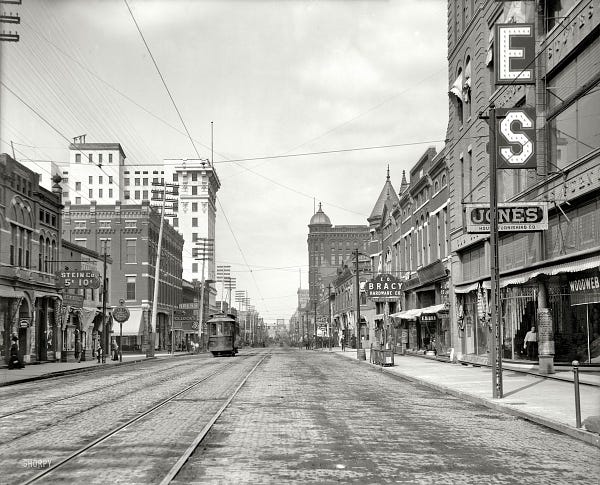I saw this tweet last month from a fellow who runs a great Northern Virginia YIMBY/pro-housing group (check it out):
Some of the replies were interesting:
“Livable”
“Abundance agenda”
“Neighborhism”
“I talk about allowing small American towns to exist” (ding ding ding)
I get the gist of the question—“urbanism” = “big city,” for a lot of people—but that last answer gets at what my own answer would be. I don’t go along with that premise. Suburbia, as we understand it today, is a recent phenomenon in American life. Early suburbs built around streetcars, or even early auto-oriented suburbs, still retained a lot of quintessentially “urban” features. Commercial and residential uses were mixed or at least closer together, distances were not so great, stores and businesses were still mostly neighborhood-scaled.
American small towns, of the sort almost everybody likes to visit and stroll around, were quite “urban” in their heyday. My hometown of Flemington, a sleepy town in a sleepy county today, produced glass and ceramics in town, as well as agricultural goods from the outlying farmland. It had a train station, a hotel, and at one point had at least two small supermarkets on Main Street. And in its heyday, it never had more than 3,000 people!
Countless other American small towns were the same, functioning not as open-air museums or quaint tourist attractions but as tiny cities, surrounded not by a penumbra of low-density development but by farmland and open space.
“Urbanism” doesn’t need an alternate term, because, in my view, the ultimate end goal of urbanism is not to impose the “big city” on the rest of America, but rather to drive home the fact that the history of America’s places before 1930-1950 is urban in a way that almost everyone has forgotten.


The answer is Little Rock, Arkansas. If that photo is from 1950, then Little Rock had only a hair over 100,000 people. In 1920, it had only 65,000 people.
The idea that single-family suburbs are the ur-American settlement is profoundly ahistorical, and so is the idea that small towns and small cities are just cultural or aesthetic amenities. The big, growing American cities where the YIMBY movement arose may inform a lot of housing discourse, but it’s also important to rediscover what America’s towns and cities were like before the suburban era.
The real dividing line isn’t between the big city and everywhere else—with small towns lumped into suburbia—but rather between suburbia and urban settlements of any size.
Related Reading:
A Hint of America’s Lost Urban History
Thanks for reading! Please consider upgrading to a paid subscription to help support this newsletter. You’ll get a weekend subscribers-only post, plus full access to the archive of over 300 posts and growing—more than one full year! And you’ll help ensure more material like this!





Great article. I love (and hate) nothing more than looking through old photos of my mid-sized city. Seeing all of the streetcars, mid-rise buildings, mixed use, and our train station. All of that is gone, replaced by freeways that rip apart the city and parking lots that are empty 80% of the time.
of course street cars were present in small towns and street car suburbs. But the fact is our 'merican roots are unfortunately very English, colonial, and set up as single homes on a homestead---that's how we started until urbanism was imported to Boston, New York, Philadelphia in the 17th century "georgian" townhomes and such. Look up colonial Williamsburg. This is a real problem for us in 'merica
:) https://upload.wikimedia.org/wikipedia/commons/a/ac/Colonial_Williamsburg_Map.jpg